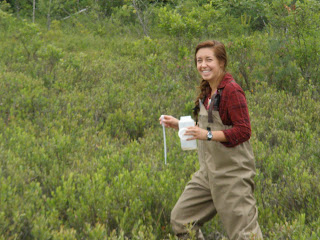 My project for this summer studies the extraordinary carnivorous pitcher plant, Sarracenia purpurea. I am working with Aaron Ellison and Benjamin Baiser on a newly funded research project that studies the widespread issue of tipping points. Tipping points are the change from one state to another. These can occur in many different systems, such as in the atmosphere or even in the economy. While it is difficult to predict the changes, we study tipping points to attempt to prevent them from happening because it is energy and resource expensive to return from a change.
My project for this summer studies the extraordinary carnivorous pitcher plant, Sarracenia purpurea. I am working with Aaron Ellison and Benjamin Baiser on a newly funded research project that studies the widespread issue of tipping points. Tipping points are the change from one state to another. These can occur in many different systems, such as in the atmosphere or even in the economy. While it is difficult to predict the changes, we study tipping points to attempt to prevent them from happening because it is energy and resource expensive to return from a change.
To test tipping points, we are looking at the aquatic micro-ecosystem within pitcher leafs of Sarracenia purpurea. The bacteria within the pitcher leaf can undergo a state change from aerobic to anaerobic when there is an overabundance of nutrients. We will be use the pitcher leaf as our model aquatic system to find the enrichment rate that produces the longest tipping period. With a long tipping period achieved through our tests, the next
experiment can run tests to intervene and prevent this state change from
occurring.
The first step in the experiment to discover is to gather the water from inside the native growing pitcher plants from Tom Swamp in Petersham, MA. This water contains the natural growing bacteria and other organisms that are unique to the pitcher plant and make up the micro-ecosystem within the leaves of the plant. The biggest challenge here is not falling into the bog!
After we collect the water from the pitchers, we filter it to make sure it contains the aerobic bacteria. Then, we put this liquid into our pitcher plants in a greenhouse that mimics a natural field setting. From here, we can control variables that affect the plant, including the amount of nutrients that the plant receives.
Enrichment levels are controlled by feeding the plants varying levels of wasps, a common prey for the pitcher plants in their natural environment. When a pitcher receives too much enrichment, it turns anaerobic. This means that the pitcher can’t take up carbon dioxide fast enough to supply sufficient oxygen to the organisms that decompose the prey. This is also known as a eutrophic state, similar to what happens in lakes when there are excess nutrients.
After supplying different levels of enrichment to our pitcher plants, we measure the dissolved oxygen in the pitcher because the oxygen level is an indicator of when a state change has occurred. For example, 0% oxygen means the pitcher is anaerobic. The oxygen level is measured using oxygen probes that sit within the pitcher being tested. By tracking the changes, we can identify the enrichment rate associated with the longest tipping period before a change of state.
Finding this enrichment rate is crucial to the next steps of the experiment. It will be used to apply management and prevention of a state change in a natural ecosystem. Following this, proteomic analysis will be done to find a reliable indicator that can give early warning before a state change. Then the unwanted state change could ultimately be prevented, and this process can be used in other natural systems.
This amazing summer opportunity has already given me valuable experiences that I wont forget. I love working in a greenhouse and caring for carnivorous plants as I never thought I would be feeding plants!






No comments:
Post a Comment